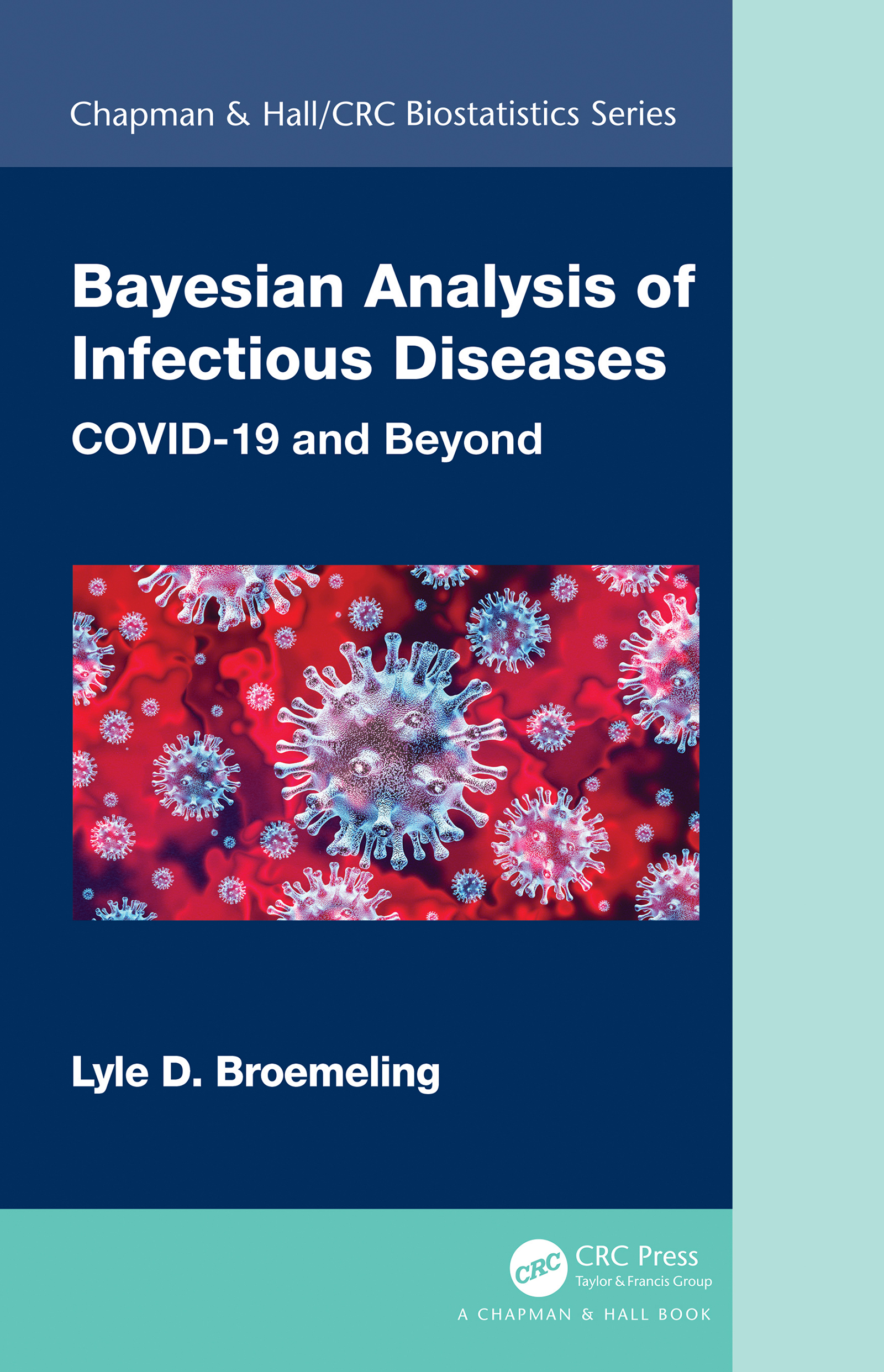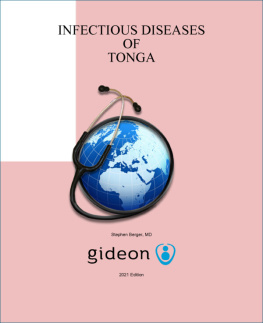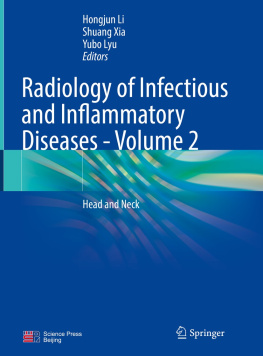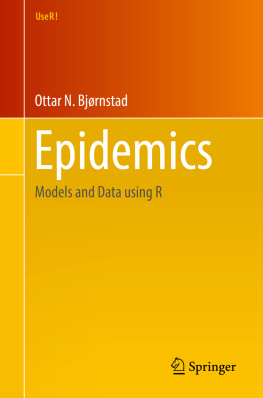
Table of Contents
Guide
Pages
Bayesian Analysis of Infectious Diseases
Chapman & Hall/CRC Biostatistics Series
Series Editors
Shein-Chung Chow, Duke University School of Medicine, USA
Byron Jones, Novartis Pharma AG, Switzerland
Jen-pei Liu, National Taiwan University, Taiwan
Karl E. Peace, Georgia Southern University, USA
Bruce W. Turnbull, Cornell University, USA
Recently Published Titles
Biomarker Analysis in Clinical Trials with R
Nusrat Rabbee
Interface between Regulation and Statistics in Drug Development
Demissie Alemayehu, Birol Emir, Michael Gaffney
Innovative Methods for Rare Disease Drug Development
Shein-Chung Chow
Medical Risk Prediction Models: With Ties to Machine Learning
Thomas A Gerds, Michael W. Kattan
Real-World Evidence in Drug Development and Evaluation
Harry Yang, Binbing Yu
Cure Models: Methods, Applications, and Implementation
Yingwei Peng, Binbing Yu
Bayesian Analysis of Infectious Diseases
COVID-19 and Beyond
Lyle D. Broemeling
Statistical Meta-Analysis using R and Stata, Second Edition
Ding-Geng (Din) Chen and Karl E. Peace
Advanced Survival Models
Catherine Legrand
Structural Equation Modeling for Health and Medicine
Douglas Gunzler, Adam Perzynski and Adam C. Carle
For more information about this series, please visit: https://www.routledge.com/Chapman--Hall-CRC-Biostatistics-Series/book-series/CHBIOSTATIS
First edition published 2021
by CRC Press
6000 Broken Sound Parkway NW, Suite 300, Boca Raton, FL 33487-2742
and by CRC Press
2 Park Square, Milton Park, Abingdon, Oxon, OX14 4RN
2021 Lyle D. Broemeling
CRC Press is an imprint of Taylor & Francis Group, LLC
The right of Lyle D. Broemeling to be identified as author of this work has been asserted by him in accordance with sections 77 and 78 of the Copyright, Designs and Patents Act 1988.
Reasonable efforts have been made to publish reliable data and information, but the author and publisher cannot assume responsibility for the validity of all materials or the consequences of their use. The authors and publishers have attempted to trace the copyright holders of all material reproduced in this publication and apologize to copyright holders if permission to publish in this form has not been obtained. If any copyright material has not been acknowledged, please write and let us know so we may rectify in any future reprint.
Except as permitted under U.S. Copyright Law, no part of this book may be reprinted, reproduced, transmitted, or utilized in any form by any electronic, mechanical, or other means, now known or hereafter invented, including photocopying, microfilming, and recording, or in any information storage or retrieval system, without written permission from the publishers.
For permission to photocopy or use material electronically from this work, access
Trademark notice: Product or corporate names may be trademarks or registered trademarks and are used only for identification and explanation without intent to infringe.
Library of Congress Cataloging-in-Publication Data
ISBN: 9780367633868 (hbk)
ISBN: 9781003125983 (ebk)
Typeset in Palatino
by SPi Global, India
Lyle D. Broemeling, Ph.D., is Director of Broemeling and Associates Inc., and is a consulting biostatistician. He has been involved with academic health science centers for about 20 years and has taught and been a consultant at the University of Texas Medical Branch in Galveston, The University of Texas MD Anderson Cancer Center and the University of Texas School of Public Health. His main interest is in developing Bayesian methods for use in medical and biological problems and in authoring textbooks in statistics. His previous books are Bayesian Biostatistics and Diagnostic Medicine, and Bayesian Methods for Agreement.
This book will introduce the reader to the latest Bayesian techniques that analyze the behavior of infectious diseases. A preview of the book is presented, followed by a list of references, and ending with online resources that provide information about emerging infectious diseases and allied subjects.
describes the foundation of Bayesian statistics. First, Bayesian theorem is given for both discrete and continuous measurements. This necessitates an explanation of the components of Bayes theorem, namely prior information, the posterior distribution of the unknown parameters, and the predictive distribution of future observations. Also provided in this chapter are many examples that illustrate Bayes theorem, among then the standard populations, such as the binomial, the normal, the Poisson, the multivariate normal, and the multinomial, and the Dirichlet.
explicates the biology and evolutionary behavior of infectious diseases, including viral and bacterial manifestations of the contagion. Next to be explained is that of the immune response via antibodies that attack the invading pathogens. The immune response involves various blood cells (white, red, and platelets) that defend against the disease. Next to be described are drugs that attempt to destroy the components of the disease. A good example of this is quinine and related drugs that control the malaria virus, and drugs that can nearly eradicate the HIV virus of AIDS patients. Although drugs have been very successful in controlling diseases, drug resistance can become a serious issue. This was the case for streptomycin, the breakthrough drug that controlled tuberculosis, but later developed a resistance. Of course, vaccines were a giant advance in medical theory, and one first thinks of the smallpox vaccine against polio. Of course, there are many examples of vaccines, such as those against measles, mumps, and diphtheria. It should be noted that for some viruses, a vaccine is yet to be developed. AIDS and Ebola do not have vaccines, but a very successful treatment for AIDS is successful, but not for Ebola. Of course, transmission of the disease from animals to humans plays an important role in the biology of emerging diseases. It is thought that the coronavirus first appeared in animals (birds, pigs, etc.) in China and was later transmitted to humans in the latter months in 2019. Ebola is believed to have been transmitted by nonhuman African primates to human.
lays the foundation for Bayesian inference of discrete time Markov chain. The concepts of limiting distributions, transient and recurrent states, ergodic chains, and the period of a chain are defined and explained.
presents biological examples of discrete time Markov chains including (1) birth and death processes, (2) logistic growth processes, (3) epidemic processes, (4) deterministic version of epidemics, (5) the stochastic version of epidemics, (6) chain binomial epidemic models, (7) the Greenwood Model, (8) The Reed-Frost Model, and (9) the duration and size of an epidemic. Lastly, the chapter consists of the explanation of statistical concepts necessary to understand epidemics.
is about the Bayesian analysis of continuous time Markov chains, such as the Poisson process. Of primary importance is the estimation of the parameter of the Poisson process via its posterior distribution. Associated subjects of the Poisson process are thinning and superposition, the spatial Poisson process, and concomitant Poisson processes. Also discussed are non-homogeneous Poisson processes and its intensity function. The chapter ends with an explanation of the important question about the coronavirus: Why are more tests needed than was originally thought to be necessary?











